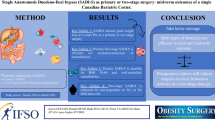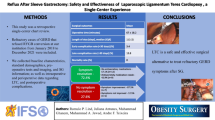Abstract
Although laparoscopic adjustable gastric banding (LAGB) has been found to be a generally successful weight loss operation, many patients require revision for weight regain, mechanical complications or intolerance to restriction. We report our experience with laparoscopic mini-gastric bypass (LMGB) as a revisional procedure for failed primary LAGB. From June 2007 to November 2012, 48 patients, who had undergone LAGB, underwent revisional surgery to LMGB. Patient demographics, reasons for band removal, interval between removal and LMGB, operative times, complications, change in comorbidities, and weight loss were collected. The revisions to a mini-gastric bypass (MGB) were completed laparoscopically in all cases except in four, when the MGB was deferred because of gastric tube damage. Mean age was 38 years (range 20–59) and BMI was 43.4 ± 4.2 kg/m2; 82 % of patients were females. Revision was performed after a mean of 28.6 months. The mean hospital stay was 3.25 days. Within 60 days of the MGB, mortality and morbidity were nil. We observed a significant difference in mean BMI after 6 months’ follow-up (P < 0.001). Diabetes remission was observed in 88 % of patients, apnea remission in 66 %, and hypertension remission in 66 % after LMGB (p < 0.001). Moreover, four patients with GERD were cured. All LAGB patients had positive outcomes after the conversion to MGB, with a mean gain of 1.7 points in the bariatric analysis and reporting outcome system questionnaire. Our results suggested that LMGB is a safe, feasible, effective and easy-to-perform revisional procedure for failed LAGB.
Similar content being viewed by others
References
Biondi A, Grosso G, Mistretta A, Marventano S, Toscano C, Drago F, Gangi S, Basile F (2013) Laparoscopic vs. open approach for colorectal cancer: evolution over time of minimal invasive surgery. BMC Surg 13(Suppl 2):S12
Biondi A, Grosso G, Mistretta A, Marventano S, Toscano C, Gruttadauria S, Basile F (2013) Laparoscopic-assisted versus open surgery for colorectal cancer: short- and long-term outcomes comparison. J Laparoendosc Adv Surg Tech A 23:1–7
Agresta F, De Simone P, Leone L, Arezzo A, Biondi A, Bottero L, Italian Society Of Young Surgeons (SPIGC) et al (2004) Laparoscopic appendectomy in Italy: an appraisal of 26,863 cases. J Laparoendosc Adv Surg Tech A 14:1–8
Grosso G, Biondi A, Marventano S, Mistretta A, Calabrese G, Basile F (2012) Major postoperative complications and survival for colon cancer elderly patients. BMC Surg 12(Suppl 1):S20
Robert M, Poncet J, Boulez J, Mion F, Espalieu P (2011) Laparoscopic gastric bypass for failure of adjustable gastric banding: a review of 85 cases. Obes Surg 21:1513–1519
Suter M, Calmes JM, Paroz A et al (2006) A 10-years experience with laparoscopic gastric banding for morbid obesity: high long-term complication and failure rates. Obes Surg 16:829–835
Topart P, Becouarn G, Ritz P (2009) One-year weight loss after primary or revisional Roux-en-Y gastric bypass for failed adjustable gastric banding. Surg Obes Relat Dis 5:459–462
De Maria EJ, Sugerman HJ, Meador JG et al (2001) High failure rate after laparoscopic adjustable silicone gastric banding for treatment of morbid obesity. Ann Surg 223:809–818
Gagner M, Gumbs AA (2007) Gastric banding: conversion to sleeve, bypass, or DS. Surg Endosc 21:1931–1935
Bueter M, Thalheimer A, Wierlemann A et al (2009) Reoperations after gastric banding: replacement or alternative procedure? Surg Endosc 23:334–340
Weiss HG, Kirchmayr W, Klaus A et al (2004) Surgical revision after failure of laparoscopic adjustable gastric banding. Br J Surg 91:235–241
Westling A, Ohrvall M, Gustavsson S (2002) Roux-en-Y gastric bypass after previous unsuccessful gastric restrictive surgery. J Gastrointest Surg 6:206–211
Gagner M, Gentileschi P, De Csepel J et al (2002) Laparoscopic reoperative bariatric surgery: experience from 27 consecutive patients. Obes Surg 12:254–260
Peterli R, Donadini A, Peters T, Ackermann C, Tondelli P (2002) Re-operations following laparoscopic adjustable gastric banding. Obes Surg 12:851–856
Weber M, Muller MK, Michael JM et al (2003) Laparoscopic Roux-en-Y gastric bypass, but notrebanding, should be proposed as rescue procedure for patients with failed laparoscopic gastric banding. Ann Surg 238:827–833
Rutledge R (2001) The mini-gastric bypass: experience with the first 1274 cases. Obes Surg 11:276–280
Rutledge R, Walsh TR (2005) Continued excellent results with the mini-gastric bypass: six year study in 2410 patients. Obes Sur. 15:1304–1308
Lee Wei-Jei, Yu Po-Jui, Wang Weu, Chen Tai-Chi, Wei Po-Li, Huang Ming-Te (2005) Laparoscopic Roux-en-Y versus mini gastric bypass for the treatment of morbid obesity. Ann Surg 242:20–28
Noun R, Skaff J, Riachi E, Daher R, Antoun NA, Nasr N (2012) One thousand consecutive mini-gastric bypass: short and long term outcome. Obes Surg 22:697–703
Piazza L, Ferrara F, Bellia A, Leanza S, Coco D, Sarvà S, Di Stefano C, Basile F, Biondi A (2011) Laparoscopic mini-gastric bypass: short-term single-institute experience. Updates Surg 63:239–242
Rutledge R (2006) Revision of failed gastric banding to mini gastric bypass. Obes Surg 16:521–523
Noun R, Zeidan S, Riachi E, Abbound B, Chalhoub V, Yazigi A (2007) Mini-gastric bypass for revision of failed primary restrictive procedures: a valuable option. Obes Surg 17:684–688
Calmes JM, Giusti V, Suter M (2005) Reoperative laparoscopic Roux-en-Y gastric bypass: an experience with 49 cases. Obes Surg 15:316–322
Oria HE, Moorehead MK (2009) Updated bariatric analysis and reporting outcome system (BAROS). Surg Obes Relat Dis 5:60–66
Suter M, Giusti V, Heraief E et al (2003) Laparoscopic gastric banding. Surg Endosc 17:1418–1425
Vijgen GHEJ, Schouten R, Pelzers L, Greve JW, Van Helden SH, Bouvy ND (2011) Revision of laparoscopic adjustable gastric banding: success or failure? Obes Surg. doi:10.1007/s11695-011-0556-1
Chevallier J-M, Zinzindohoué F, Douard R et al (2004) Complications after laparoscopic adjustable gastric banding for morbid obesity: experience with 1,000 patients over 7 years. Obes Surg 14:407–414
Samuel I, Mason EE, Renquist KE et al (2006) Bariatric surgery trends: an 18-year report from the international bariatric surgery registry. Am J Surg 192:657–662
Shouten R, Van Dielen FM, Greve JW (2006) Re-operation after laparoscopic adjustable gastric banding leads to a further decrease in BMI and obesity-related co-morbidities: results in 33 patients. Obes Surg 16:821–828
Nesset EM, Kendrick ML, Hounghton SG et al (2007) A two-decade spectrum of revisional bariatric surgery at a tertiary referral center. Surg Obes Relat Dis 3:25–30
Roller JE, Provost DA (2006) Revision of failed gastric restrictive operations to Roux-en-Y gastric bypass: impact of multiple prior bariatric operations on outcome. Obes Surg 16:865–869
Author information
Authors and Affiliations
Corresponding author
Ethics declarations
Conflict of interest
The authors declare that they have no conflict of interest.
Ethical approval
All procedures performed in studies involving human participants were in accordance with the ethical standards of the institutional and/or national research committee and with the 1964 Helsinki Declaration and its later amendments or comparable ethical standards.
Research involving human participants and/or animals
No animals but only human participants were engaged in our study.
Informed consent
Informed consent was obtained from all individual participants included in the study.
Rights and permissions
About this article
Cite this article
Piazza, L., Di Stefano, C., Ferrara, F. et al. Revision of failed primary adjustable gastric banding to mini-gastric bypass: results in 48 consecutive patients. Updates Surg 67, 433–437 (2015). https://doi.org/10.1007/s13304-015-0335-y
Received:
Accepted:
Published:
Issue Date:
DOI: https://doi.org/10.1007/s13304-015-0335-y




